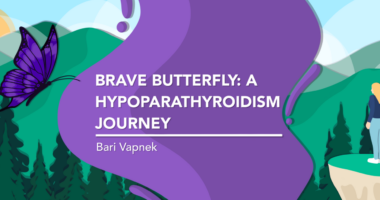With hypopara, curiosity about worsening symptoms is crucial
After months of consistent pain, I may have found the answer

Earlier this year, I experienced significant shoulder pain. I blamed it on my hypoparathyroidism, assuming it was from a muscle spasm, one of my frequent symptoms. Instead, the pain turned out to be from a pinched nerve beneath my shoulder blade. While my disease was a contributing factor, it was not the root cause.
Learning not to blame all my symptoms on hypopara (another name for my disease) was an important lesson. It was also something I thought about more frequently as I pushed back another deadline because of too many high-pain days in a row. “I didn’t use to feel this much pain every day, right?” I thought. “Sure, I have scoliosis and hypopara, but could this be something different?”
“Maybe it’s your medication?” a friend suggested, but the pain wasn’t widespread, just consistent in my hips and my shoulder and neck area.
“Maybe it’s grief?” my physical therapist wondered. Grief can cause an increase in pain levels, but there’d been no decrease even as my grief from losing multiple loved ones this year had become more tolerable.
“Maybe it’s the weather?” another practitioner said. Except there didn’t seem to be a variation with temperature changes.
At first, I was able to explain it all away. Earlier this year, I wrote a book for my grandma while she was in hospice, and the breakneck pace to finish it in time had left my shoulders and neck in significant pain. But six months after finishing that book, I still struggled to type. My shoulder throbbed after only a few hundred words. My hips ached every time I sat at my desk in a supportive recliner. I’d been resting, exercising, doing physical therapy, and getting massages, but nothing seemed to help.
A restless night prompts a realization
Last week, when my discomfort woke me yet again at 4 a.m., I recalled the trip to Florida to visit my grandma back in February. We stayed at a Hilton hotel that had a hybrid mattress, which utilizes both foam and springs. For a week, my hip pain nearly subsided. The day after I returned home to my all-foam mattress, it returned with a vengeance.
When I brought up the change in my hip pain to my medical team, the best anyone could do was guess. Maybe it had been the warm weather, or maybe the adrenaline from the situation, and I couldn’t rule out that my focus was simply on my grandma rather than on my pain. It was my massage therapist, however, who suggested I look at a new mattress.
I made a mental note to research mattresses, but then got lost in writing my new book. I didn’t have time to embark on the challenging journey of finding and testing new bedding. After all, my mattress was probably fine.
Nearly eight months after the conversation with my massage therapist, I finally did the math on how old my bed was: 13 years. That was three years past the recommended life of our foam mattress. I grabbed my phone to research and stumbled across a mattress topper that looked promising in the interim.
When the topper arrived, I slept on it for two nights and confirmed my hypothesis: My pain was heavily affected by my mattress. While my neck and shoulders couldn’t tolerate the softness of the foam, my hip pain decreased by 40% over the first two nights.
Despite the topper not being a long-term solution, I finally had an answer!
My first plan had been to purchase a Hilton mattress from the hotel’s website; however, their branded beds have a “no refund or exchange” policy. At a four-figure price point, I found that risk unreasonable. However, knowing that I can sleep soundly on a hybrid mattress has given me a starting point.
As I embark on the stressful but important task of trying to find a new bed, I am extremely hopeful that this will be the key to alleviating some of my consistent pain. I’m just sorry it took me eight months to dig into my massage therapist’s advice. This was another important example of why being curious about new or worsening symptoms is important when living with a rare disease.
Note: Hypoparathyroidism News is strictly a news and information website about the disease. It does not provide medical advice, diagnosis, or treatment. This content is not intended to be a substitute for professional medical advice, diagnosis, or treatment. Always seek the advice of your physician or another qualified health provider with any questions you may have regarding a medical condition. Never disregard professional medical advice or delay in seeking it because of something you have read on this website. The opinions expressed in this column are not those of Hypoparathyroidism News or its parent company, Bionews, and are intended to spark discussion about issues pertaining to hypoparathyroidism.







Leave a comment
Fill in the required fields to post. Your email address will not be published.